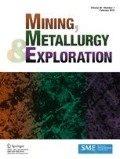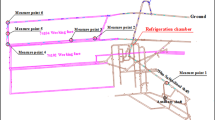Abstract
Built-in-place (BIP) refuge alternatives (RAs) are designed to provide a secure space for miners who cannot escape during a mine emergency. Heat and humidity buildup within RAs may expose miners to physiological hazards such as heat stress. To minimize the risk of heat stress, Title 30 Code of Federal Regulations (CFR), or 30 CFR, mandates a maximum allowable apparent temperature (AT) for an occupied RA of 35 °C (95 °F) (MSHA 2008 [1]). The National Institute for Occupational Safety and Health (NIOSH) has conducted extensive research on the thermal environment of occupied RAs intended for use in underground coal mines. NIOSH research has demonstrated that a fully occupied BIP RA can exceed the AT limit by > 5.6 °C (10 °F) in mines with elevated mine strata and air temperatures (Bissert et al. 2017 [2]). In this circumstance, an RA cooling system could provide a solution. This paper provides an overview of test methodology and findings as well as guidance on improving the performance of a cryogenic air system prototype by optimizing the flow rate, increasing the tank storage capacity, and improving the efficiency of the heat exchanger of the cryogenic system. This may enable BIP RAs to meet the 35 °C (95 °F) AT limit in mines with elevated temperatures. The information in this paper is useful for RA manufacturers and mines that may choose to implement a cryogenic air system as a heat mitigation strategy.













Similar content being viewed by others
References
MSHA (2008) 30 CFR Parts 7 and 75; Refuge alternatives for underground coal mines; final rule. U.S. Department of Labor, Mine Safety and Health Administration
Bissert P, Yantek DS, Yan L, Srednicki JR, Yonkey JA (2017) The effects of seasonal heat and humidity on mine strata temperatures in underground coal mines. SME Annual Meeting, Denver 19–22 Feb 2017
Yan L, Yantek D, Reyes M, Damiano N, Srednicki J, Bickson J, Whisner B, Bauer E (2018) Cooling systems for refuge alternatives in hot mine conditions. ASME 2018 International Mechanical Engineering Congress & Exposition (IMECE), Pittsburgh, 9–15 Nov 2018
Yantek D (2014) Investigation of temperature rise in mobile refuge alternatives. Publication No. 2014-117 (RI 9695), U.S. Department of Health and Human Services, Centers for Disease Control and Prevention, National Institute for Occupational Safety and Health, Office of Mine Safety and Health Research
Disclaimer
The findings and conclusions in this paper are those of the authors and do not necessarily represent the official position of the National Institute for Occupational Safety and Health, Centers for Disease Control and Prevention. Mention of any company or product does not constitute endorsement by NIOSH.
Author information
Authors and Affiliations
Corresponding author
Ethics declarations
Conflict of Interest
The authors declare that they have no conflict of interest.
Additional information
Publisher’s Note
Springer Nature remains neutral with regard to jurisdictional claims in published maps and institutional affiliations.
Rights and permissions
About this article
Cite this article
Yan, L., Yantek, D., Reyes, M. et al. Cryogenic Air Supply for Cooling Built-in-Place Refuge Alternatives in Hot Mine. Mining, Metallurgy & Exploration 37, 861–871 (2020). https://doi.org/10.1007/s42461-020-00194-w
Received:
Accepted:
Published:
Issue Date:
DOI: https://doi.org/10.1007/s42461-020-00194-w




